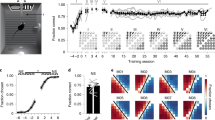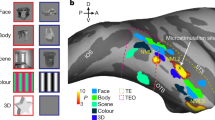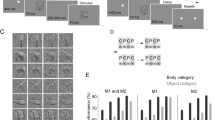Abstract
The hippocampus, amygdala and entorhinal cortex receive convergent input from temporal neocortical regions specialized for processing complex visual stimuli and are important in the representation and recognition of visual images. Recording from 427 single neurons in the human hippocampus, entorhinal cortex and amygdala, we found a remarkable degree of category-specific firing of individual neurons on a trial-by-trial basis. Of the recorded neurons, 14% responded selectively to visual stimuli from different categories, including faces, natural scenes and houses, famous people and animals. Based on the firing rate of individual neurons, stimulus category could be predicted with a mean probability of error of 0.24. In the hippocampus, the proportion of neurons responding to spatial layouts was greater than to other categories. Our data provide direct support for the role of human medial temporal regions in the representation of different categories of visual stimuli.
This is a preview of subscription content, access via your institution
Access options
Subscribe to this journal
Receive 12 print issues and online access
$209.00 per year
only $17.42 per issue
Buy this article
- Purchase on Springer Link
- Instant access to full article PDF
Prices may be subject to local taxes which are calculated during checkout






Similar content being viewed by others
References
Logothetis, N. K. & Sheinberg, D. L. Visual object recognition. Annu. Rev. Neurosci. 19, 577 –621 (1996).
Tanaka, K. Inferotemporal cortex and object vision. Annu. Rev. Neurosci. 19, 109–139 (1996).
Gross, C. G. How inferior temporal cortex became a visual area. Cereb. Cortex 5, 455–469 (1994).
Suzuki, W. A. Neuroanatomy of the monkey entorhinal, perirhinal and parahippocampal cortices: Organization of cortical inputs and interconnections with amygdala and striatum . Sem. Neurosci. 8, 3–12 (1996).
Saleem, K. S. & Tanaka, K. Divergent projections from the anterior inferotemporal area TE to the perirhinal and entorhinal cortices in the macaque monkey. J. Neurosci. 16, 4757– 4775 (1996).
Leonard, C. M., Rolls, E. T., Wilson, F. A. W. & Baylis, G. C. Neurons in the amygdala of the monkey with responses selective for faces. Behav. Brain. Res 15, 159–176 (1985).
Suzuki, W., Miller, E. & Desimone, R. Object and place memory in the macaque entorhinal cortex . J. Neurophysiol. 78, 1062– 1081 (1997).
Miyashita, Y., Rolls, E. T., Cahusac, P. M. B., Niki, H. & Feigenbaum, J. D. Activity of hippocampal formation neurons in the monkey related to a conditional spatial response task. J. Neurophysiol. 61, 669–678 (1989).
Mishkin, M. Memory in monkeys severely impaired by combined but not separate removal of amygdala and hippocampus. Nature 273, 297 –298 (1978).
Meunier, M., Bachevaoer, J., Mishkin, M. & Murray, E. A. Effects on visual recognition of combined and separate ablations of the entorhinal and perirhinal cortex in rhesus monkeys. J. Neurosci. 13, 5418–5432 (1993).
Tranel, D., Damasio, H. & Damasio, A. Face agnosia and the neural substrates of memory. Annu. Rev. Neurosci. 13, 89–109 (1990).
Warrington, E. & McCarthy, R. Categories of knowledge — Further fractionations and an attempted integration. Brain 110, 1273–1296 (1987).
Fried, I., Mateer, C., Ojemann, G., Wohns, R. & Fedio, P. Organization of visuospatial functions in human cortex . Brain 105, 349–371 (1982).
Penfield, W. & Jasper, H. Epilepsy and the Functional Anatomy of the Human Brain (Little, Brown, Boston, 1954).
Treisman, A. M. & Kanwisher, N. G. Perceiving visually presented objects: recognition, awareness, and modularity. Curr. Opin. Neurobiol. 8, 218–226 (1998).
Ishai, A., Ungerleider, L. G., Martin, A., Schouten, J. L. & Haxby, J. V. Distributed representation of objects in the human ventral visual pathway. Proc. Natl. Acad. Sci. USA 96, 9379–9384 (1999).
Martin, A., Wiggs, C. L., Ungerleider, L. G. & Haxby, J. V. Neural correlates of category-specific knowledge. Nature 379, 649–652 (1996).
Allison, T. et al. Face recognition in human extrastriate cortex. J. Neurophysiol. 71, 821–825 (1994).
Nobre, A., Allison, T. & McCarthy, G. Word recognition in the human inferior temporal lobe . Nature 372, 260–263 (1994).
Tong, F., Nakayama, K., Moscovitch, M., Weinrib, O. & Kanwisher, N. Response properties of the human fusiform face area. Cognit. Neuropsychol. 17, 257–279 (2000).
Fried, I., MacDonald, K. A. & Wilson, C. Single neuron activity in human hippocampus and amygdala during recognition of faces and objects. Neuron 18, 753–765 (1997).
Wilson, M. A. & McNaughton, B. L. Dynamics of the hippocampal ensemble code for space. Science 261, 1055 –1058 (1993).
Keeping, E. S. Introduction to Statistical Inference (Dover, New York, 1995).
Adolphs, R., Tranel, D., Damasio, H. & Damasio, A. Impaired recognition of emotion in facial expressions following bilateral damage to the amygdala . Nature 372, 669–672 (1994).
Buckley, M. J. & Gaffan, D. Perirhinal cortex ablation impairs object identification. J. Neurosci. 18, 2268–2275 (1998).
Kanwisher, N., McDermott, J. & Chun, M. M. The fusiform face area: a module in human extrastriate cortex specialized for face perception. J. Neurosci. 17, 4302–4311 (1997).
Epstein, R. & Kanwisher, N. A cortical representation of the local visual environment. Nature 392, 598 –601 (1998).
Epstein, R., Harris, A., Stanley, D. & Kanwisher, N. The parahippocampal place area: recognition, navigation, or encoding? Neuron 23, 115–125 (1999).
Allison, T., Puce, A., Spencer, D. & McCarthy, G. Electrophysiological studies of human face perception. I: Potentials generated in occipitotemporal cortex by face and non-face stimuli. Cereb. Cortex 9, 415–430 (1999).
Klopp, J., Halgren, E., Marinkovic, K. & Nenov, V. Face-selective spectral changes in the human fusiform gyrus. Clin. Neurophysiol. 110, 676–682 (1999).
Halgren, E., Raij, T., Marinkovic, K., Jousmaki, V. & Hari, R. Cognitive response profile of the human fusiform face area as determined by MEG. Cereb. Cortex 10, 69–81 (2000).
Ojemann, J. G., Ojemann, G. A. & Lettich, E. Neuronal activity related to faces and matching in human right nondominant temporal cortex. Brain 115, 1–13 (1992).
Ojemann, G. A., Ojemann, S. G. & Fried, I. Lessons from the human brain: neuronal activity related to cognition. The Neuroscientist 4, 285– 300 (1998).
Scoville, W. B. & Milner, B. Loss of recent memory after bilateral hippocampal lesions. J. Neurol. Neurosurg. Psychiatry. 20, 11–21 (1957).
Penfield, W. & Milner, B. Memory deficit produced bilateral lesions in the hippocampal zone. Arch. Neurol. Psychol. 79, 475–479 (1958).
Zola-Morgan, S. & Squire, L. R. Neuroanatomy of memory. Annu. Rev. Neurosci. 16, 547– 563 (1993).
McNaughton, B. L. & Nadel, L. in Neuroscience and Connectionist Theory (ed. Seifert, W.) 1– 64 (Academic, New York, 1990).
Alvarez, P. & Squire, L. R. Memory consolidation and the medial temporal lobe: a simple network model. Proc. Natl. Acad. Sci. USA 91, 7041–7045 (1994).
Treves, A. & Rolls, E. T. Computational analysis of the role of the hippocampus in memory. Hippocampus 4, 374–391 (1994).
Young, M. P. & Yamane, S. Sparse population coding of faces in the inferior temporal cortex. Science 256, 1327–1331 (1992).
Logothetis, N. K. & Pauls, J. Psychophysical and physiological evidence for viewer-centered object representations in the primate . Cereb. Cortex 3, 270– 288 (1995).
Muller, R. A quarter of a century of place cells. Cell 17, 813–822 (1996).
Aguirre, G. K., Detre, J. A., Alsop, D. C. & D'Esposito, M. The parahippocampus subserves topographical learning in man. Cereb. Cortex 6, 823–829 (1996).
Maguire, E. A. et al. Knowing where and getting there: a human navigation network . Science 280, 921–924 (1998).
Heit, G., Smith, M. E. & Halgren, E. Neural encoding of individual words and faces by the human hippocampus and amygdala. Nature 333, 773–775 (1988).
Fried, I. et al. Cerebral microdialysis combined with single-neuron and electroencephalographic recording in neurosurgical patients. J. Neurosurg. 91, 697–705 (1999).
Efron, B. & Tibshirani, R. J. An Introduction to the Bootstrap (Chapman & Hall/CRC, London, 1993).
Yakovlev, V., Fusi, S., Berman, E. & Zohary, E. Inter-trial neuronal activity in inferior temporal cortex: a putative vehicle to generate long-term visual associations. Nat. Neurosci. 1, 310 –317 (1998).
Miyashita, Y. Neuronal correlate of visual associative long-term memory in the primate temporal cortex. Nature 335, 817– 820 (1988).
Green, D. & Swets, J. Signal Detection Theory and Psychophysics (Wiley, New York, 1966).
Acknowledgements
This work was supported by grants from NIH (to I.F.), the Keck Foundation (to C.K.) and the Center for Consciousness Studies, University of Arizona (to I.F. and C.K.). We would like to thank D. Rozenfarb and M. Zirlinger for suggestions and reading the manuscript and Peter Steinmetz for general discussion. We wish to acknowledge Tony Fields, Jack Morrow, Eve Isham, Charles Wilson, Rick Staba, Eric Behnke and Anatol Bragin for help with the recordings.
Author information
Authors and Affiliations
Corresponding author
Rights and permissions
About this article
Cite this article
Kreiman, G., Koch, C. & Fried, I. Category-specific visual responses of single neurons in the human medial temporal lobe. Nat Neurosci 3, 946–953 (2000). https://doi.org/10.1038/78868
Received:
Accepted:
Issue Date:
DOI: https://doi.org/10.1038/78868
This article is cited by
-
Single-neuron mechanisms of neural adaptation in the human temporal lobe
Nature Communications (2023)
-
Distinct beta frequencies reflect categorical decisions
Nature Communications (2023)
-
Consciousness: a neurosurgical perspective
Acta Neurochirurgica (2023)
-
A human single-neuron dataset for face perception
Scientific Data (2022)
-
Face identity coding in the deep neural network and primate brain
Communications Biology (2022)



